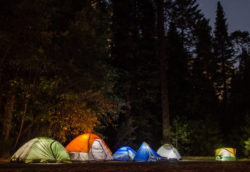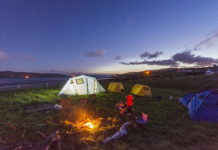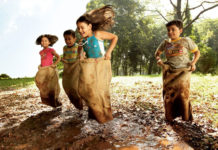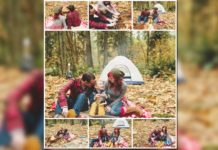There are many factors involved if you want to take your camping experience to the next level. But the first time comes across would be how to choose a Campsite? Choosing a suitable Campsite becomes an integral part of your camping plan. You must know what to look for, or more importantly, what to avoid.
The backpacking experience is good only when you find a good camping site which could contribute to a great trip. More importantly, you must know that poor Campsite can cause a lot of problems. You surely do not want to camp with an inch of ants crawling around or struggle with the odd weather. Hence you must choose wisely your Campsite and avoid the very basic mistakes that we have seen people making. Also, safety considerations when choosing Campsite is very important.
Let us see some rules for choosing a campsite and tips to make your experience better:

1. Plan in Advance
The most important thing starts with planning. You must know in advance where you can find the Campsite along the trail. You can also consult online resources or go through a guidebook to discuss and think about your options. There would be specific Campsite in a few areas that you would have to select.
2. Some Camping Site Could be Closed
Due to the over usage of the camping site, there are fair possibilities that it could be closed. You must know the local rules and follow them. A very good idea is to contact the Land management agency, for you can have a quick check for the camping regulations on the requirement for a permit. You can ask about the availability of the chosen site. Also, there are few sites which allow larger camping groups. Hence it is also good to know if you need to split. Most of the camping sites have group size regulations that you must know and plan.

3. Advance Reservation
If you know that you are going to go camping, it is worth booking your Campsite in advance. Most of the popular hiking destinations are busy throughout the year. Get your moment as early as possible before you might have to look for an alternate camping site.
4. Plan your Arrival Time
Schedule your days and plan in a way that you reach your Campsite two hours at the least before sunset. This helps you to plan and look at your Campsite and settle before twilight gets over.
5. Characteristics of a Good Campsite must have a Minimum Impact on Environment
You must set your tent on a durable rock or background surface or even gravel or sand to protect the areas that are fragile. It is always safe to camp on an established Campsite as much as possible. Although, you must remember that a perfect Campsite is found, and not made by itself. Low impact camping site does protect the environment from harm, and also ensures the quality of the Campsite is maintained for future campers. Look for a camping site where the ground is a little elevated as compared to the relatively flat surfaces to avoid any petals in case of rain. Thus Campsite must not be in a depression.

6. Select a Location where you can Relax
Having spoken about the train and specifications of the environment, you cannot forget that you want to relax amidst the beautiful landscape. Soak up in the beauty of nature by selecting a campsite overlooking waterfall or surrounded by trees or mountains to relax. Look for your privacy such that you choose a Campsite away from the trails and out of the other camper’s view. Make sure your location is perfect enough for the morning sun to rise and warm you up and the afternoon shade to shield you from the hot sun. Avoid areas with heavily tensed mosquito’s insects. Mosquitoes are mostly found in marshy places with still water or tall grasses growing. Is the area is breezy; it can keep the mosquito and insect numbers down. Ticks, ants, other bugs live and tall grassy meadows which must be avoided.
7. Safety Considerations while Choosing a Campsite
You cannot be camping in a rocky Terrain full of snakes. Or a site is known for avalanches or rock slides. You must also never camp at the bottom of the cliff risking falling rocks or loose rocks. If you come near the water bodies, understand the higher level mark for water in a dry stream bed all the rivers subject to flash floods. You might want to consider Poison Ivy or oak areas. Do not come on a site which has fallen tree leaning on another one. A dense stand of trees, large boulders or rock outcroppings are natural ways to protect against high winds. You must not correct at a Campsite with tall and dominant trees or single standing tree as it becomes the target for lightning. You must choose a Campsite to make sure it is safe.

8. Stealth Camping
If you are not camping on an established side, it is referred to as stealth camping or wild camping. And especially in this type of camping, it becomes the responsibility of the hiker to practice no trace principle. You must avoid making any fire unless there is an emergency situation, breaking off branches in order to make space for your camp or uprooting the plants. Also, when it is time for you to leave the Campsite, you must remove any and print from your shelter before moving.

9. Care During Winter Season
You must come either on bare ground or the snowfield ground with little or no plants. This is because camping on the snow reduces any impact on the environment. However, you must avoid any animal tracks such that you do not disturb the wildlife. Cold as usually turns to collect and hence it is recommended that you must camp on a higher rather than a lower area.
Especially during the winter season, you might want the sun to arrive first in the morning and position your tent accordingly to receive the full throttle sun to energize you. Also, examine the surface as it must not have a Frost texture or any brittle texture with might indicate the harsh wind pattern.
You must leave such a Campsite and search for another safer one. Keep a watch on the weather report and look for the signs of Avalanche activities. Do you have any Avalanche debris in the area below you? Look for the trees that were moved into the past Avalanche. If you have signs of an avalanche, it is best to move to another area. Select your camp tent to protect you well from the weather.
10. Keep Your Campsite Clean
This is the utmost important point to keep your side clean. Although this is very obvious, for some people it makes it compulsory to mention.
Now you know how to choose a Campsite but proper planning is very important. After all, you are camping to relax and rejuvenate. Always have a backup plan ready to have an alternate established Campsite to choose from. You would be more relaxed when you are prepared and less likely to have any surprises on negative impact. Happy camping and keep reading with us. Share your experiences in the comment section. We love to hear from you.









































